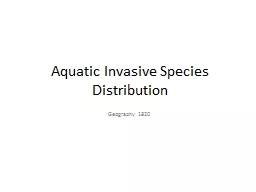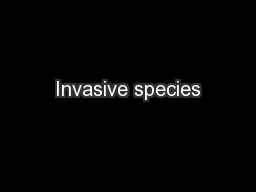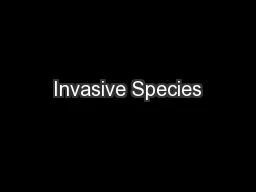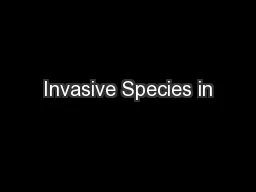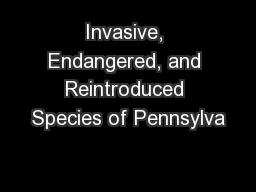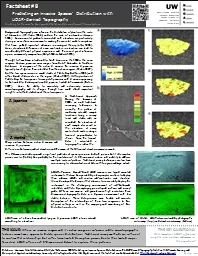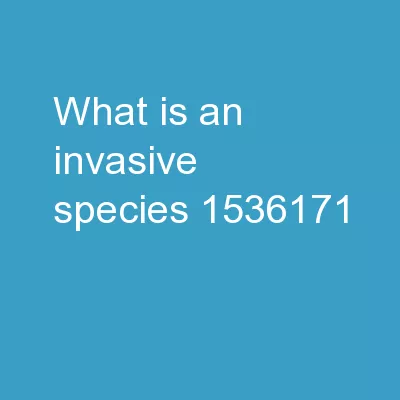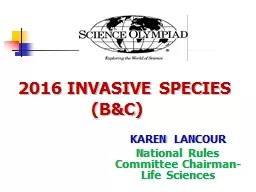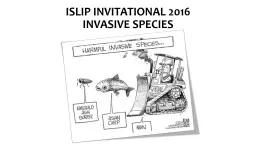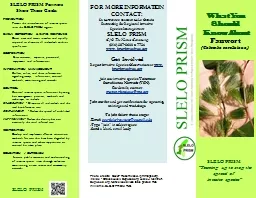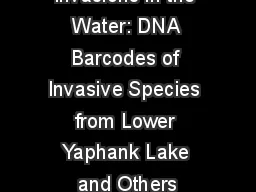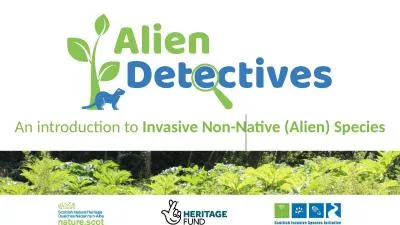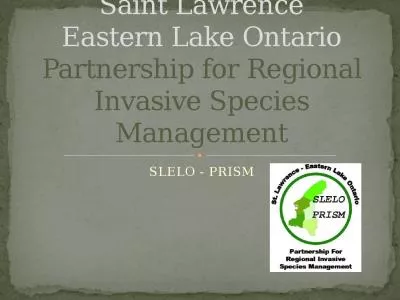PPT-Aquatic Invasive Species Distribution
Author : conchita-marotz | Published Date : 2017-04-28
Geography 1820 Background Information Aquatic invasive species AIS are organisms and plants that have been introduced to new ecosystems and are both harming natural
Presentation Embed Code
Download Presentation
Download Presentation The PPT/PDF document "Aquatic Invasive Species Distribution" is the property of its rightful owner. Permission is granted to download and print the materials on this website for personal, non-commercial use only, and to display it on your personal computer provided you do not modify the materials and that you retain all copyright notices contained in the materials. By downloading content from our website, you accept the terms of this agreement.
Aquatic Invasive Species Distribution: Transcript
Geography 1820 Background Information Aquatic invasive species AIS are organisms and plants that have been introduced to new ecosystems and are both harming natural resources and threating human use of resources. Bullies in nature. An Introduction to Invasive Species. Bullies in nature. What are Invasive Non Native Species?. Invasive species are bullies in nature. Non Native species would not be here naturally. „But the cardoon (Cynara cardunculus) has a far wider range.: it now occurs in these latitudes on both sides of the Cordillera across the continent. I saw it in unfrequented spots in Chile, Entre Rios, and Banda oriental. In the latter country alone, very many (probably several hundred) square miles are covered with one mass of these prickly plants, and are impenetrable by man or beast. Over the undulating plains, where these great beds occur, nothing else can live. Before their introduction, however, I apprehend the surface supported as in other parts a rank herbage. I doubt whether any case is on record of an invasion of so grand scale of one plant over the aborigines”. An introduction. What is a . native species?. Native species are those that normally live and thrive in a particular community. They occupy specific habitats and have specific niches in their native environment. They have natural predators that help to keep their populations in check.. British . Columbia: . Introduction. An Online Course for BC Parks Staff, . Volunteers and Contractors. Welcome! . Course . Goal: . provide an introduction to invasive species in BC, explore their impacts, highlight key species for BC Parks regions, and learn how to report invasive species. . By: Elizabeth S. Butler. Pd. 3. What is an Endangered Species?. An Endangered Species is a species of animal that is on the brink of extinction. The . endangered . animal is usually close to extinction because of . Wolbachia. within Aquatic Insects of . t. he Missouri River and Associated Drainages. Eric J Sazama. , Carmelita . Shouldis. , Scot P Ouellette, Jeff S Wesner . What is . Wolbachia. ?. Intracellular alpha-. LiDAR-derived Topography. Citation: . Hannam, M.,L.M. Moskal and S. Wyllie-Echeverria, 2009. Predicting an Invasive Species’ Distribution with LiDAR-derived Topography. Factsheet # 8. Remote Sensing and Geospatial Application Laboratory, University of Washington, Seattle, WA. Digital version of the fact sheet can be downloaded at: . WA definition (RCW 79A.25.310):. Non-native (alien) to ecosystem. Cause economic or environmental harm. Capable of spreading. NOT livestock, intentional crops, non-harmful exotics. Any type of living thing. KAREN LANCOUR. National Rules Committee Chairman- Life Sciences. Event Rules – 2016. . DISCLAIMER. . This presentation was prepared using draft rules. There may be some changes in the final copy of the rules.. STATION #1. INVASIVE SPECIES #1. INVASIVE SPECIES #2. STATION. #1. Provide the common name for . INVASIVE SPECIES #1. [1]. Provide the common name for . INVASIVE SPECIES #2. [1]. Identify the sex of the adult shown in the image for . SLELO PRISM “Teaming up to stop the spread of invasive species” FOR MORE INFORMATION CONTACT: St. Lawrence Eastern Lake Ontario Partnership for Regional Invasive Species Management Invasions in the Water: DNA Barcodes of Invasive Species from Lower Yaphank Lake and Others Alex Corozza 1 , Alfredo Delcastillo 1 , Preeti Ramesh Kumar 1 Connetquot Highschool 1 Help! . Our local wildlife is under threat from Alien invaders!. We need you to become Alien Detectives…... Could you learn about alien species, what they are, where they come from and what they are doing here?. Eastern Lake Ontario. Partnership for Regional Invasive Species Management. What is a PRISM?. A regional partnership of diverse stakeholders formed to address the threat of invasive species in a cooperative, comprehensive, cost‐effective way across a designated geographical area..
Download Document
Here is the link to download the presentation.
"Aquatic Invasive Species Distribution"The content belongs to its owner. You may download and print it for personal use, without modification, and keep all copyright notices. By downloading, you agree to these terms.
Related Documents

